Seymour Cray and his cars
September 28, 1925 in Chippeua Falls, Wisconsin, was born Seymour Roger Cray. This talented engineer and inventor created some of the best computers of his time. Since school years he is interested in radio engineering and chemistry. After graduating from school, in 1943, he served in the American army as an operator of a radio station and deciphered Japanese messages. After serving in the army, Seymour Cray enters the University of Minnesota, where in 1950 he received a bachelor's degree in electrical engineering, and in 1951 a master's degree in applied mathematics.
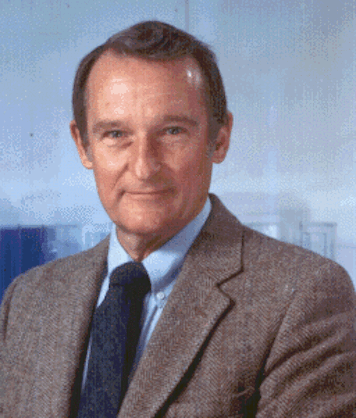
Seymour Cray (1925 - 1996)
')
In 1951, he began working at Engineering Research Associates (ERA), which specializes in creating cryptographic equipment for the US Navy. A little later in 1952, Remington Rand acquires it and joins the UNIVAC Division.
In 1947, ERA signed a Task 13 contract with the US Navy, according to which they create the first electronic computer with a stored program called Atlas. And in late 1950, it was launched at the US National Security Agency.
But, despite the fact that this electronic computer was classified, in December 1951, the leadership of ERA sought permission to modify it and launch it for sale. It goes under the brand ERA 1101 (i.e. “13” in binary code) and Seymour Cray, participating in the work on the new machine, in fact, creates its first experimental computer.

Fragment of the magnetic drum ERA 1101
True, the machine is not in demand, as it does not work with punch cards and it does not issue instructions for operation and programming. The company wanted to sell machine time to everyone for what in 1953-1954. they collect ERA 1101 for their office. But the plan failed and at the end of 1954 the car was handed over for operation to the Technical Institute of the State of Georgia.
The latest model that Seymour Cray worked on at Sperry-Rand, before his transition to the CDC, was ERA / UNIVAC 1103.
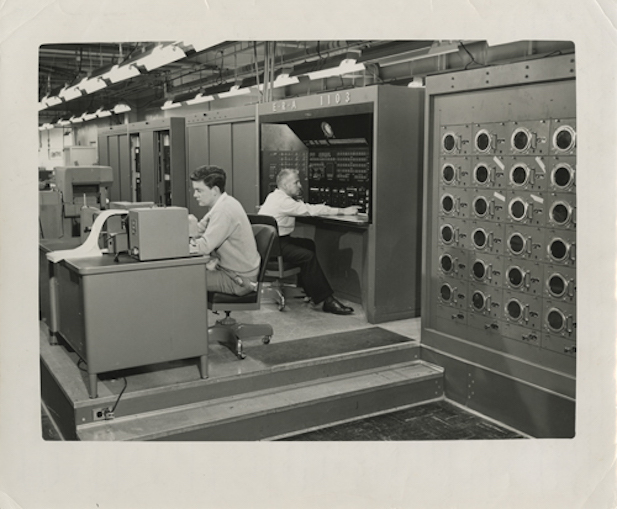
The machine used memory on 36 Williams electrostatic tubes 5 inches in diameter each. They could store 1024 bits of data. The RAM was based on a magnetic drum with a capacity of 16384 words. Electrostatic memory and the memory on the drum were addressed directly: addresses from 0 to 01777 (in octal recording) gave access to electrostatic memory, and addresses from 040000 to 077777 (in octal recording) - to the drum. Numbers with a fixed comma were expressed as follows: 1 bit was assigned to the sign, and 35 bits - to the value, where negative numbers were represented by the reverse code. And in floating-point numbers, 1 bit was assigned to a character, 8 bits to an order of magnitude and 27 bits to a mantissa. The instructions consisted of 6 bits of the opcode and two 15-bit value addresses.
Engineering Research Associates asks the Armed Forces Security Administration to allow the use of an Atlas II computer for commercial purposes. They receive such permission if they remove a certain number of specialized instructions. And already in early 1953, the new machine entered the market, called UNIVAC 1103, competing with the IBM 701 computer. The first UNIVAC 1103 is purchased by the US Air Force to use in the Eglin-based ballistic missile program in Florida. And after the presentation of the computer, in the same 1953 year, in Los Angeles at a computer conference, the company receives orders from Convair, Boeing, Lockheed and the White Sands Missile Range army training ground.
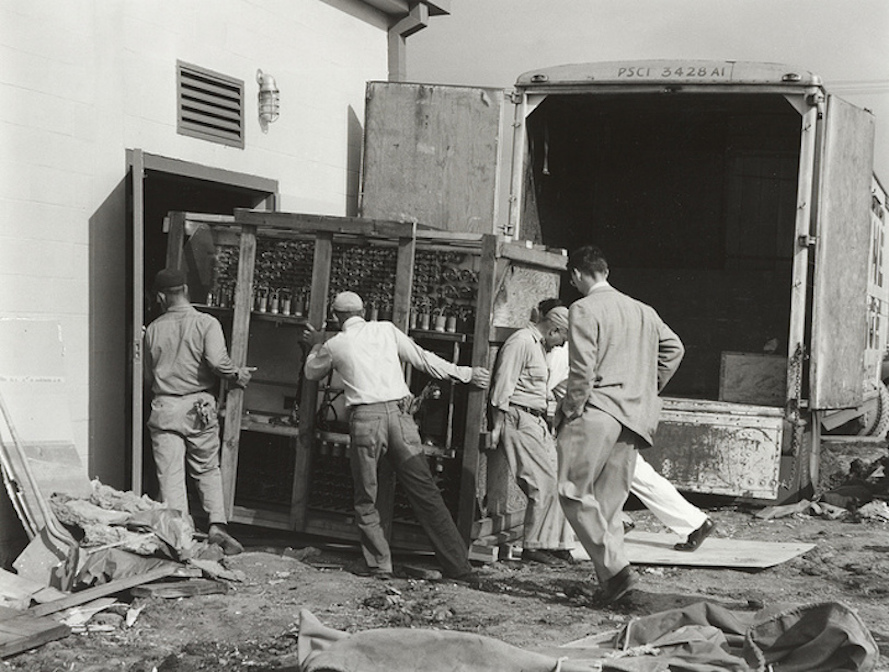
Installation UNIVAC, 1953
Sperry Rand saw its perspective in new orders and an increase in computer sales, rather than in research projects. Therefore, in 1957, they reduce the computer division and a number of developers leave, founding the company CDC (Control Data Corporation).
Cray, as the lead engineer of the state project Naval Tactical Data System, finishes it and by investing its $ 5,000 in the company's authorized capital, joins the CDC.
Arriving at Control Data Corporation, Seymour Cray immediately plunges into work. The first development of the company, under the leadership of Kray, to become a high-speed model of the CDC 1604 with a clock frequency of 0.2 MHz (takt time 5 microseconds). Based on research conducted by Sperry-Rand on the design of a navigation system for intercontinental ballistic missiles and on experiments with “Little Character”, Cray built the first full-fledged computer CDC 1604, which worked on germanium transistors instead of vacuum electronic devices. In 1960, this computer was considered the fastest in the world.
These computers were sold to the Naval Postgraduate School, the Livermore National Laboratory, the University of Illinois, Northrop and Lockheed, the National Bureau of Standards, and even the Government of Israel.

CDC-1604 console
The following development took Kray only 3 days. The 12-bit version of the CDC 1604 is called the CDC 160A. It was the world's first mini-computer in size as an office desk. It was used as a data I / O console in the CDC 1604 or used as a remote terminal. In the US, its value was 110,000 dollars.
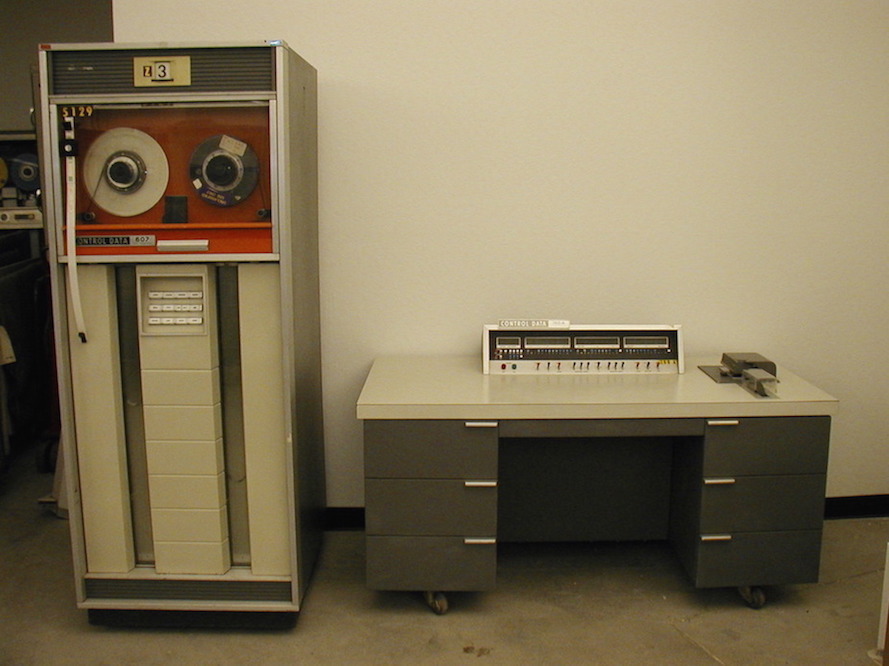
CDC 160A
In 1968 one of the obsolete models of the CDC 1604 came to the Soviet Union. It is installed in the city of Dubna at the Joint Institute for Nuclear Research. In the same place for CDC 1604, a Fortran-Dubna translator is written, program-compatible with the BESM-6 Soviet computer. In the future, the CDC 160A Cray will use as a peripheral processor in its supercomputer CDC 6600.
Comparative table of CDC-1604 and BESM-6
At Control Data Corporation, Seymour Cray had a lot of workload, including administrative and representative, which took a lot of time and energy. His authority certainly grew, but he just wanted to work on creating new computers and invest all his time and efforts only in this direction.
In order for Cray to remain at the firm, in 1962, William Norris, not far from Cray's house, builds a laboratory for him. The laboratory employs about 40 people, including 4 programmers and 14 engineers. On August 22, 1962, Control Data Corporation announces a new model: the CDC 6600, the most powerful computer at that time, and occupies a leading position in the market, relegating IBM to second place.
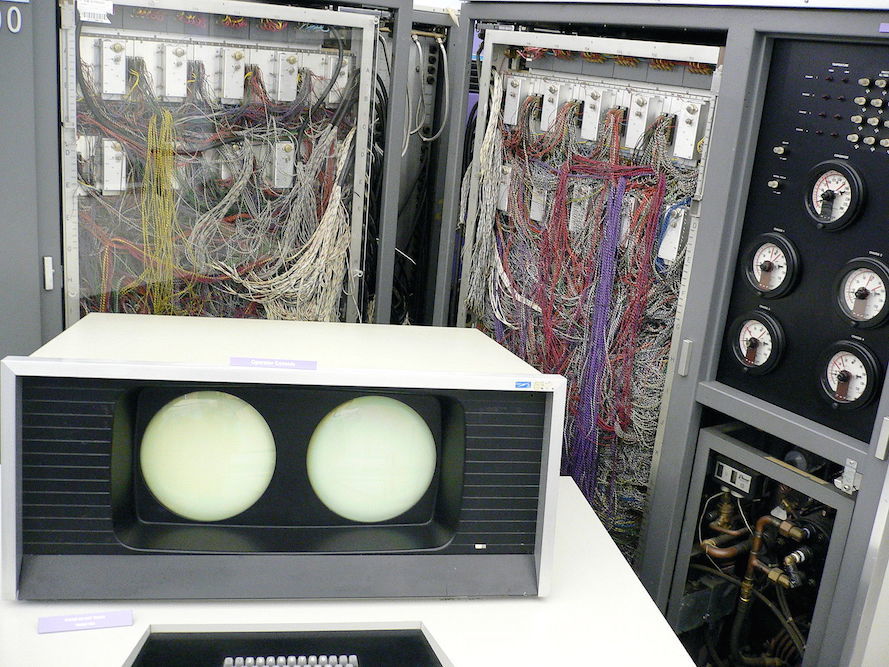
Management console and modular racks
The latest IBM model was losing to the new Kray machine by its power three times. On August 22, 1963, at Chippewa Labs, the CDC 6600 computer was introduced to a narrow circle of journalists.
The CDC 6600 computer gets the title "supercomputer". For the first time in the CDC 6600 uses several independent functional devices. It had developed software, the operational memory was divided into 32 banks with 4096 60-bit words, 1 μs memory cycle, 10 independent functional devices, silicon transistors. Theoretically, he could perform more than 3 million operations per second (although with the help of the best compilers, programmers managed to achieve only 0.5 million), for the first time he had a cooling system using freon, developed by Dean Roush. Jim Thornton, who worked on the central processor, also helped Kray work. Logical and arithmetic operations were performed by the main processor, and 10 peripheral processors read data from the input device and took the results to transfer them to the output device. Due to this, the CPU was unloaded and its commands were executed very quickly.

Cray said:
Computers CDC 6600 assembled at the factory CDC in the suburbs of the city of Saint Paul - Arden Hills. But at the request of Kray, the first five cars were collected by the staff at his laboratory, and the plant workers at Arden Hills watched the assembly and took over the experience.
The price of this computer was just over $ 7 million, while the IBM Stretch computers cost $ 13 million. The first computer was sold to the Atomic Energy Commission and the Weather Bureau, and by 1967, 63 CDC 6600 cars had already been purchased by elite customers.
Later on, taking the CDC 6600 as a basis, a series of computers are produced, cheaper in price, but significantly inferior in speed. Computers were released under the common name "Series 6000": CDC 6400 (April 1966), CDC 6500 (October 1967), CDC 6700 (October 1969). As a continuation, the CDC 6800 computer was still to be released, but Seymour Cray didn’t want to simply improve the models and decided to create a new computer based on it - the CDC 7600, which was the next stage in the history of the development of supercomputers.
In 1969, the next Kray CDC 7600 computer was released. Its clock frequency was 37 MHz. The CDC 7600 was the first to use a combination of parallel and pipelining. And to improve the work of the conveyor, each of its “stages” was represented as a separate electronic unit containing several printed circuit boards with components placed one above the other. This made it possible to make the system compact, but if any of the boards broke, the entire unit failed.
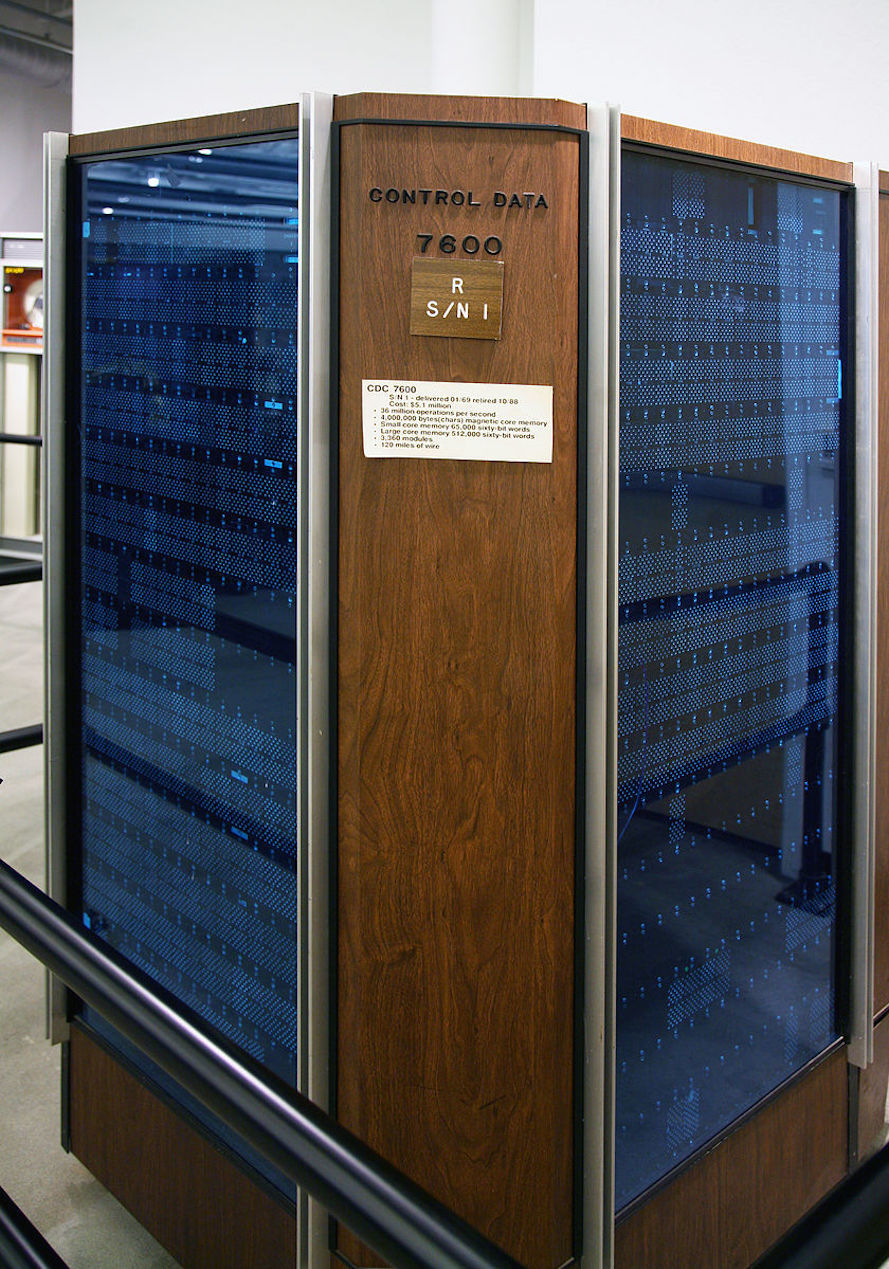
CDC 7600 series №1
The CDC 7600 was 4 times faster than the CDC 6600 and cost 7.5 million dollars. But despite the differences between these computers, thanks to the Fortran compiler, they were compatible. 100 pieces of CDC 7600 were purchased at prices ranging from 6 to 10 million dollars, depending on the configuration of computers.
The following CDC 8600 model represented the unification of four CDC 7600 computers into one common system. They worked at a frequency of 125 MHz and had a general access to RAM of 2 MB. Each processor of the new system worked 2.5 times faster than the CDC 7600, and this increased the performance by almost 10 times. But at the same time, the reliability of the entire system was quite low and the CDC 8600 did not enter the market.

Layout CDC 8600, probably made for promotional purposes.
Cray realizes that a new car is needed and appeals to William Norris, executive director of Control Data Corporation, to support the new project. However, Norris refuses to him, as the company concentrates all its strength on the development of STAR-100 (developer CDC engineer, Jim Thornton). After that, in 1972, Cray, with a team of engineers, leaves with Control Data Corporation and organizes his own firm, Cray Research.
Taking into account all the disadvantages and advantages of their previous computers and the latest development of STAR-100 Control Data Corporation, Krai takes on the creation of a new machine.
The basis of the computer laid parallel processing of information. Instead of transistors in a new machine, Cray uses integrated circuits and a vector processor; raises time per clock up to 12.5 ns (80 MHz); The microprocessor used 12 conveyor functional modules, divided into four groups - address, scalar, vector and group for handling floating-point numbers (order - 15, mantissa - 49). The system performance was 180 million operations per second with a floating point.
Small-size memory modules (“vector registers”) are created, which operate at high speed and are close to the processor, which makes it possible to perform scalar and vector calculi rather quickly. Random access memory (64 bits wide) consists of 16 independent blocks of 64 Kb words each. Its volume covers 1048576 machine words (8 MB). Register memory is divided into five groups of registers, a total of 152 pcs. The system also had a special buffer memory for intermediate storage of commands executed by the program, consisting of four sections of 16 machine words each. The central processor used a new register-register memory principle. It receives data from the registers and writes them there.
Since the Cray-1 was a fundamentally different computer, Kray did not need to combine it with previous machines. Cray-1 was a vector-pipelined computing system. The computer had a multifaceted shape, which allowed to reduce the length of the wires and increase the density of the system components. The central processor was surrounded by RAM chips from all sides, which assumed the same time to access each of them. It consisted of 500 printed circuit boards on which there were 144,000 chips cooled by freon. For more efficient cooling, the central processor had the form of a “tower” with twelve columns set in a semicircle 270 degrees long and resembling the letter “C” (from Cray), and the cooling system itself was located below the towers.
Due to the super dense integration of the components inside, Cray-1 emitted a large amount of heat. So, a powerful cooling system was required. For this purpose, a special installation is developed, where liquid freon is used for cooling.
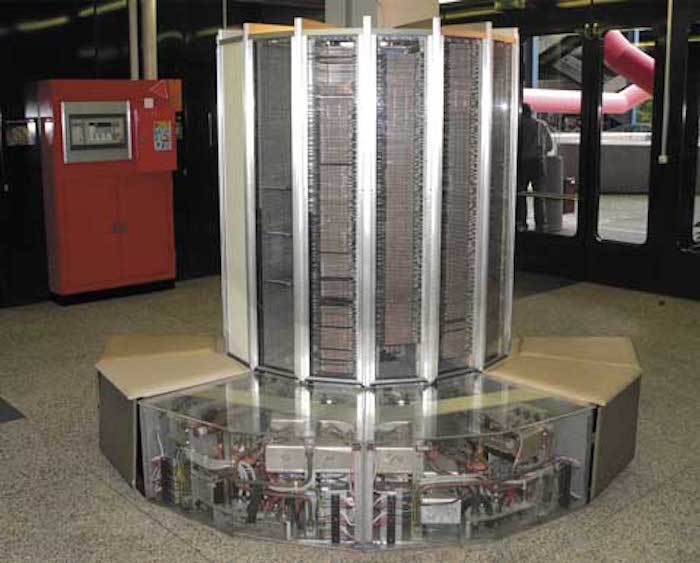
Cray-1 cooling system
Copper plates with Teflon coating are installed between the modules, which collect heat and take it to the edges of the rack. The plates are attached to the main "cooling pipe", consisting of 12 aluminum panels "covers", inside which are steel tubes. On them passed the liquid freon cooling in the lower part of the system, in which the refrigeration unit is located. The temperature of the “highway” is 12 degrees Celsius, and in the central part of the modules it can rise to 54 degrees. In general, the temperature of the computer was below room temperature and this made it possible to install it in a room even without air conditioning.
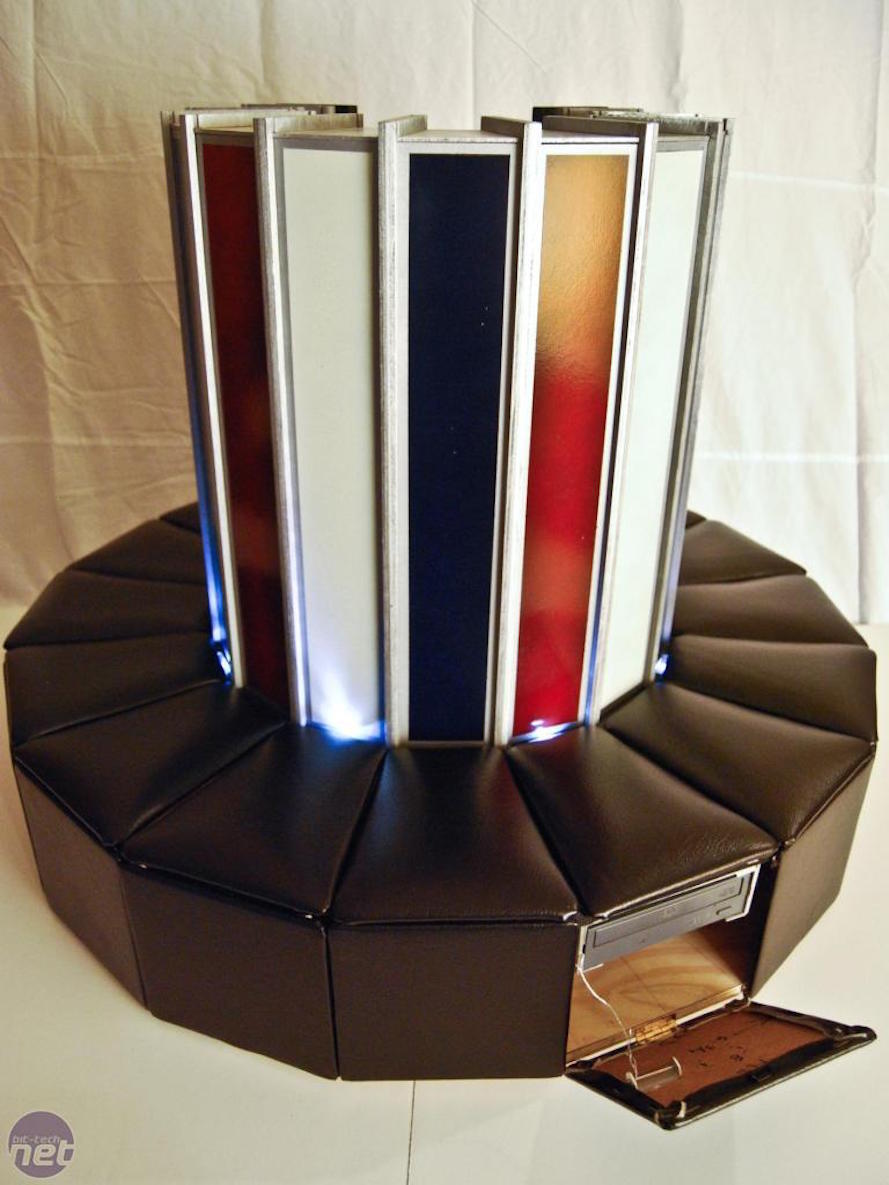
The case of the lower part of the supercomputer was covered with a layer of soft filler, and externally resembled seats, from which it was jokingly called "the most expensive chair in the world"
All Cray-1 electronics were hidden in a polyhedron with sixteen faces with a diameter of 150 cm and a height of 195 cm. The weight of the system reached 6 tons, the power consumption was 115 kW. And the total power consumption (along with the data storage system and cooling installation) was 250 kW. Therefore, a special Power Distribution Unit device, two meters high, was independently responsible for providing power, thanks to its own diesel generator.
In 1974, the first tests of the Cray-1 computer showed its average performance equal to 80 MFLOPS. In some operations, the speed increased to 150 MFLOPS, and the maximum performance was 250 MFLOPS.
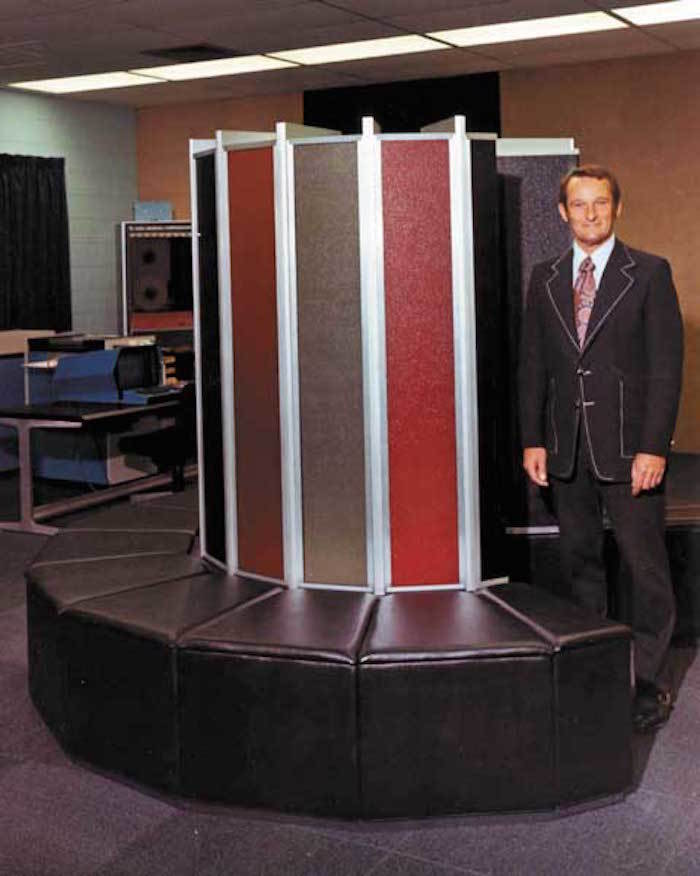
Seymour Cray in 1974, with his brainchild - computer Cray 1
In 1975, Cray Research introduces the public to the Cray-1 computer, and in March 1976, they released their first computer sample (serial number 001), which is installed in the Los Angeles Nuclear Laboratory in the USA for six months and receive excellent reviews.
It serves as a good advertisement for the sale of the next computer; The second car is sold for $ 8.86 million to the National Center for Atmospheric Research, USA. And even more than a hundred customers were interested in such an acquisition.
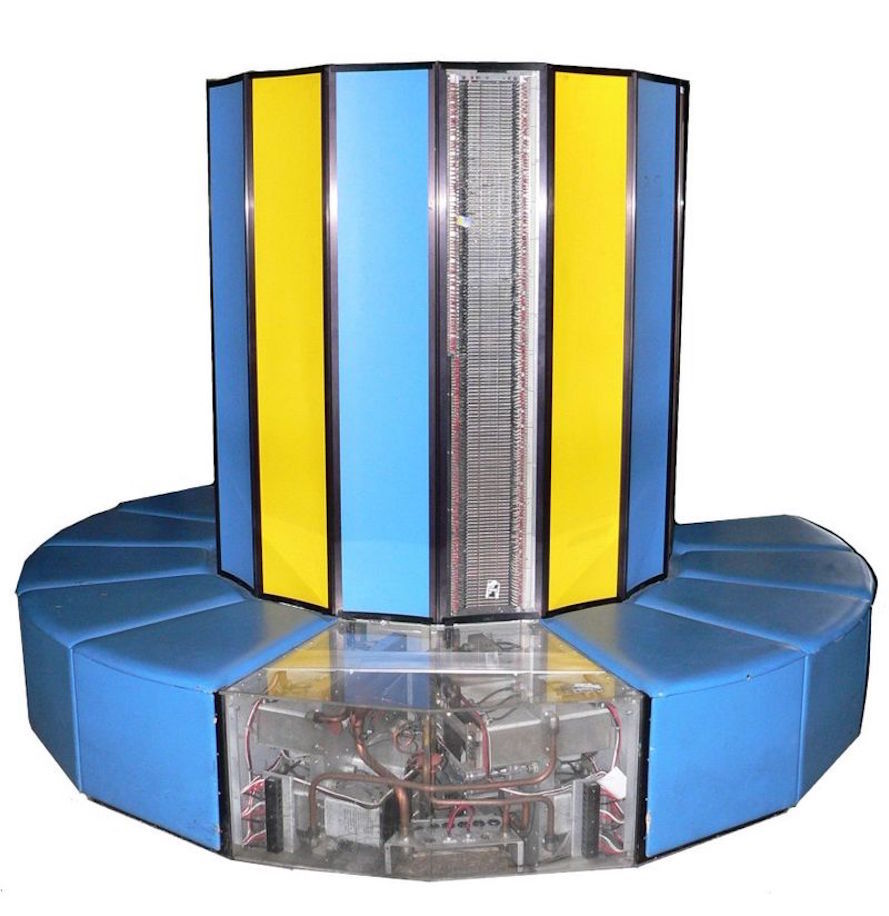
When buying Cray-1 (and later on other computers), each customer could choose the color of the edges at his discretion
But on the line, with the purchase, the Cray-1 could be rented for $ 210,500 per month (the hour of work on the Cray-1 was $ 7,500). Sales of computers Cray-1 led Cray Research to financial growth in the company and the defeat of their competitors.
Around 1976, Cray begins to develop a new Cray-2 computer. Initially it was planned as a computer with four vector processors and a clock time of 4 ns, but by 1978 it decided to change the technology and replace the 4 vector processors with 64 scalar processors. But mass-parallel computing technologies have been little studied. For a computer with mass-parallel computing, a special parallelizing compiler was needed. And Steve Nelson started working on it. A few months later, Cray is sent to the Livermore National Laboratory, to their programmers with the project of their new machine. But at that time the computer on 64 scalar processors turned out to be too progressive and were not yet ready for it. Then Seymour Cray returns to the original design.
To increase the clock frequency, Cray reduces the distance between computer elements. The length of the wires is shortened to 16 inches. The packaging becomes whiter dense, and the distance between the panels does not allow to place the plates of heat sinks, which in turn makes it difficult to remove heat. Therefore, another cooling system was needed, unlike the Cray-1.
The Cray-2 project became similar to the failed CDC 8600 project. And then Cray proposes to create a laboratory for creating integrated circuits that would fit a large amount of logic into the small dimensions of the machine. Such a laboratory appears Boldir (Colorado).
At the end of 1980, Cray hands over the management of Cray Research to John Rollvalen and devotes more time to working on Cray-2. To remove heat more efficiently, Cray in 1981 proposes to place the entire machine in an inert fluid from 3M Fluorinert (Minnesota Mining and Manufacturing Company), which was used for heart surgery. This substance was supposed to remove heat by circulating both around the car and inside it.
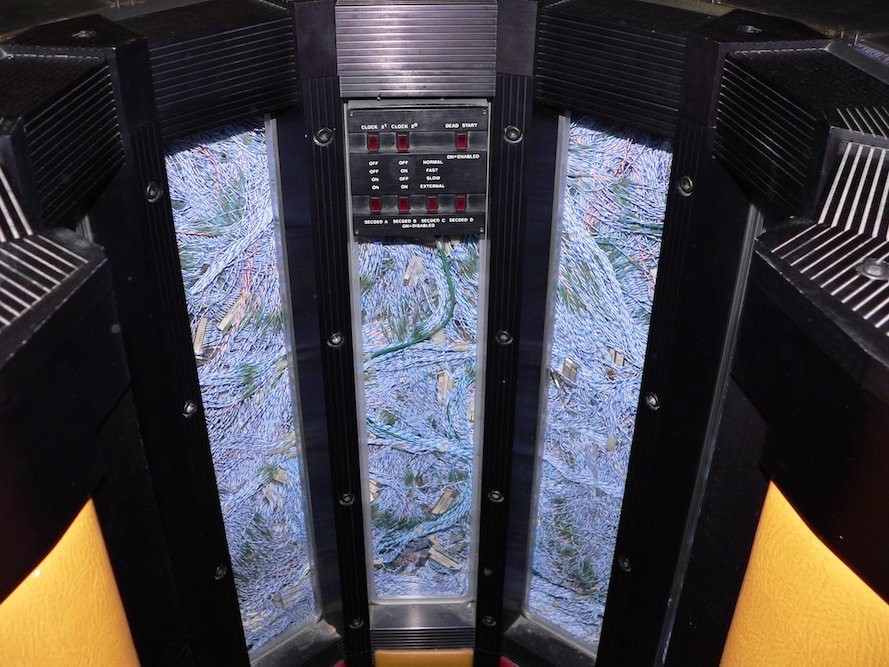
Inside Cray-2
In connection with this innovation, the need for the Boldyr laboratory and its work on VLSI disappears and in 1982 it closes. In the spring of 1985, Cray introduces the world's fastest computer Cray-2. He holds this palm until 1990 (in 1990, ETA will launch the new ETA-10G supercomputer). The first copy of Cray-2 was supplied to the Livermore National Laboratory.
The Cray-2 system had 2 or 4 vector processors (depending on the configuration), its element base consisted of an integrated circuit with 16 logic gates and emitter-coupled logic on bipolar transistors. The takt time was 4.1 ns, the memory capacity was 256 million 64-bit words. The operating system was UNIX-like Unicos or Cray Operating System. The software had two Fortran compilers: CFT2 and CFT77 with automatic vectorization of code, C compiler, macro assembler CAL, utilities and libraries for working with input-output devices and task execution organizations. The Cray-2 had full immersion liquid cooling, and the power consumption was 195 kW. Its height was 114.3 cm, diameter - 134.6 cm. The computer consisted of 14 vertical columns-racks, assembled in an arc with a length of 300 degrees.
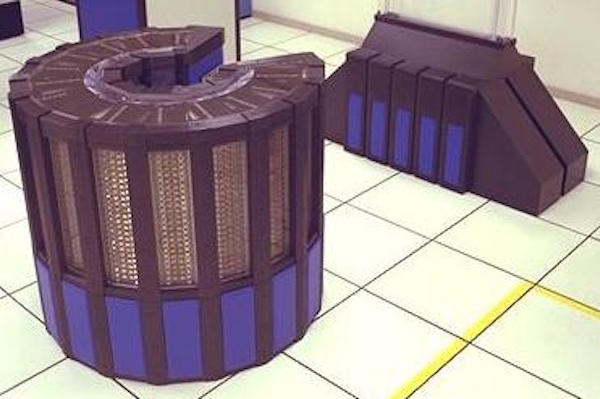
Cray-2 at NASA
The second copy of the Cray-2 in September 1985 was installed at the Ames Research Center. Initially, the Cray-2 was developed for the Department of Defense and the Department of Energy of the USA, for research in the field of nuclear weapons and oceanography, but it also found its application in peaceful areas: at NASA, at universities and corporations around the world.
Cray-2 application in NASA
The cost of Cray-2 in 1985 was 17.6 million dollars. In 1990, a single copy of the Livermore National Laboratory built an 8-processor Cray-2 worth $ 19 million. By this time, Seymour Cray is separated from Cray Research and creates a new company, Cray Computer Corp, to work on a new Cray-3 computer and support Cray-2.

The world's only 8-processor Cray-2
Since 1988, Cray begins work on a new Cray-3 machine. In order to fully devote himself to this work in May 1989, he leaves Cray Research and creates a new Cray Computer Corporation. For its part, Cray Research is investing $ 100 million in cash and 50 million in property in Kray’s new company.
To achieve high speeds in the Cray-3 model, Cray takes gallium arsenide, which is used in high-speed circuits for satellites, as the basis for its microchips. This made it possible to create microcircuits working six times faster than silicon microcircuits. But considering that gallium arsenide is very fragile, the performance of such products was very low. To test the assembled modules there was no test equipment, and Cray Computer Corporation was forced to purchase expensive equipment by special order. And this in turn influenced the further cost of the computer (over $ 30 million).
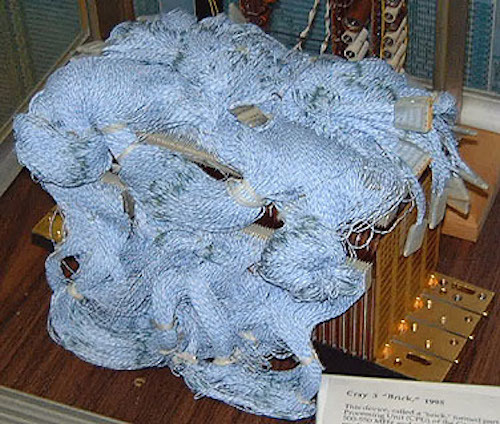
Cray 3 processor module
Cray 3 supported the installation of up to 16 processors. His performance was supposed to be the highest in the world. But he, unfortunately, is unstable. And the National Center for Atmospheric Research, being the main customer for Cray 3, ceases to allocate money for refinement.
In August 1990, Cray Computer Corporation did enter into an agreement with the Livermore National Laboratory for the sale and delivery of the first computer until June 1992. Until June 1991, the modules are completed according to the plan, but by the end of 1991 it becomes obvious that it’s time to pass the floating point unit is not possible and the contract is terminated.
As a result, the company comes a hard time. With the end of the Cold War and the reduction in defense spending, the number of companies able to buy a computer for such a price has decreased significantly. And the company decides to stop the development of 16-processor Cray-3 and find a buyer for an 8-processor computer. As a result, the world's only prototype Cray 3 is in NCAR (National Center for Atmospheric Research).
After some time, Cray Computer Corporation went bankrupt, but Cray does not stop and continues to implement his new ideas. In 1996, the new company SRC Computers appeared and the work on SG-4 continues.
It was planned that the SG-4 will have 64 processors, a clock duration of 1 ns (1 GHz clock speed) and a maximum performance of 128 GFLOPS. Work on the Sgau-4 progressed according to plan, in the future Sgau-5, and Sgau-6 were outlined. As always, Krei’s plans were to create the fastest computer in the world. But on September 22, 1996, Seymour Cray is involved in a car accident. He suffers very severe injuries to the neck and head. And on October 5, 1996, Seymour Roger Cray, aged 71, dies from his injuries.
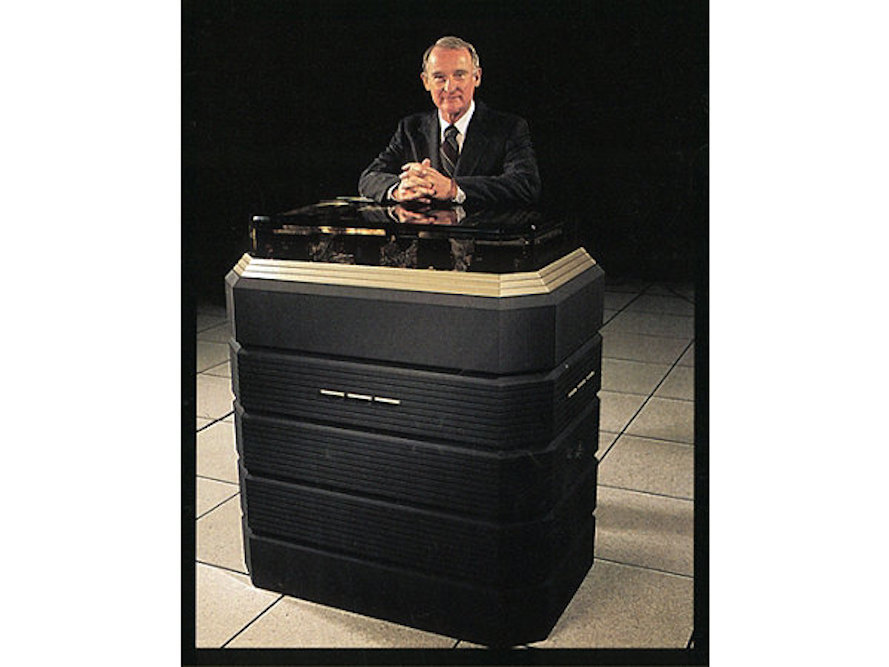
In honor of Cray, in 1997, the Seymour Cray Computer Engineering Award was established, which is presented annually to the IEEE Computer Society. During the period of its activity, Seymour Cray has created a unique line of high-end computers that have played a key role in the history of the development of supercomputers.

Seymour Cray (1925 - 1996)
')
ERA 1101 and UNIVAC 1103
In 1951, he began working at Engineering Research Associates (ERA), which specializes in creating cryptographic equipment for the US Navy. A little later in 1952, Remington Rand acquires it and joins the UNIVAC Division.
In 1947, ERA signed a Task 13 contract with the US Navy, according to which they create the first electronic computer with a stored program called Atlas. And in late 1950, it was launched at the US National Security Agency.
But, despite the fact that this electronic computer was classified, in December 1951, the leadership of ERA sought permission to modify it and launch it for sale. It goes under the brand ERA 1101 (i.e. “13” in binary code) and Seymour Cray, participating in the work on the new machine, in fact, creates its first experimental computer.

Fragment of the magnetic drum ERA 1101
True, the machine is not in demand, as it does not work with punch cards and it does not issue instructions for operation and programming. The company wanted to sell machine time to everyone for what in 1953-1954. they collect ERA 1101 for their office. But the plan failed and at the end of 1954 the car was handed over for operation to the Technical Institute of the State of Georgia.
The latest model that Seymour Cray worked on at Sperry-Rand, before his transition to the CDC, was ERA / UNIVAC 1103.

The machine used memory on 36 Williams electrostatic tubes 5 inches in diameter each. They could store 1024 bits of data. The RAM was based on a magnetic drum with a capacity of 16384 words. Electrostatic memory and the memory on the drum were addressed directly: addresses from 0 to 01777 (in octal recording) gave access to electrostatic memory, and addresses from 040000 to 077777 (in octal recording) - to the drum. Numbers with a fixed comma were expressed as follows: 1 bit was assigned to the sign, and 35 bits - to the value, where negative numbers were represented by the reverse code. And in floating-point numbers, 1 bit was assigned to a character, 8 bits to an order of magnitude and 27 bits to a mantissa. The instructions consisted of 6 bits of the opcode and two 15-bit value addresses.
Engineering Research Associates asks the Armed Forces Security Administration to allow the use of an Atlas II computer for commercial purposes. They receive such permission if they remove a certain number of specialized instructions. And already in early 1953, the new machine entered the market, called UNIVAC 1103, competing with the IBM 701 computer. The first UNIVAC 1103 is purchased by the US Air Force to use in the Eglin-based ballistic missile program in Florida. And after the presentation of the computer, in the same 1953 year, in Los Angeles at a computer conference, the company receives orders from Convair, Boeing, Lockheed and the White Sands Missile Range army training ground.

Installation UNIVAC, 1953
Sperry Rand saw its perspective in new orders and an increase in computer sales, rather than in research projects. Therefore, in 1957, they reduce the computer division and a number of developers leave, founding the company CDC (Control Data Corporation).
Cray, as the lead engineer of the state project Naval Tactical Data System, finishes it and by investing its $ 5,000 in the company's authorized capital, joins the CDC.
CDC 1604
Arriving at Control Data Corporation, Seymour Cray immediately plunges into work. The first development of the company, under the leadership of Kray, to become a high-speed model of the CDC 1604 with a clock frequency of 0.2 MHz (takt time 5 microseconds). Based on research conducted by Sperry-Rand on the design of a navigation system for intercontinental ballistic missiles and on experiments with “Little Character”, Cray built the first full-fledged computer CDC 1604, which worked on germanium transistors instead of vacuum electronic devices. In 1960, this computer was considered the fastest in the world.
These computers were sold to the Naval Postgraduate School, the Livermore National Laboratory, the University of Illinois, Northrop and Lockheed, the National Bureau of Standards, and even the Government of Israel.

CDC-1604 console
The following development took Kray only 3 days. The 12-bit version of the CDC 1604 is called the CDC 160A. It was the world's first mini-computer in size as an office desk. It was used as a data I / O console in the CDC 1604 or used as a remote terminal. In the US, its value was 110,000 dollars.

CDC 160A
In 1968 one of the obsolete models of the CDC 1604 came to the Soviet Union. It is installed in the city of Dubna at the Joint Institute for Nuclear Research. In the same place for CDC 1604, a Fortran-Dubna translator is written, program-compatible with the BESM-6 Soviet computer. In the future, the CDC 160A Cray will use as a peripheral processor in its supercomputer CDC 6600.
Comparative table of CDC-1604 and BESM-6
| Parameter \ Machine | CDC-1604 | BESM-6 |
| Start of serial release | 1960 | 1968 |
| Element base | Transistors | Transistors |
| Addressing Type | Unicast | Unicast |
| Word length | 48 bits | 48 bits |
| Team length | 24 bits | 24 bits |
| Adder Bit | 48 bits | 48 bits |
| Address bit size | 15 bits | 15 bits |
| General purpose registers | 1 (+1) | 1 (+1) |
| Index Registers | 6 | 15 |
| RAM capacity (original) | 32,768 words | 32,768 words |
CDC 6600
At Control Data Corporation, Seymour Cray had a lot of workload, including administrative and representative, which took a lot of time and energy. His authority certainly grew, but he just wanted to work on creating new computers and invest all his time and efforts only in this direction.
In order for Cray to remain at the firm, in 1962, William Norris, not far from Cray's house, builds a laboratory for him. The laboratory employs about 40 people, including 4 programmers and 14 engineers. On August 22, 1962, Control Data Corporation announces a new model: the CDC 6600, the most powerful computer at that time, and occupies a leading position in the market, relegating IBM to second place.

Management console and modular racks
The latest IBM model was losing to the new Kray machine by its power three times. On August 22, 1963, at Chippewa Labs, the CDC 6600 computer was introduced to a narrow circle of journalists.
The CDC 6600 computer gets the title "supercomputer". For the first time in the CDC 6600 uses several independent functional devices. It had developed software, the operational memory was divided into 32 banks with 4096 60-bit words, 1 μs memory cycle, 10 independent functional devices, silicon transistors. Theoretically, he could perform more than 3 million operations per second (although with the help of the best compilers, programmers managed to achieve only 0.5 million), for the first time he had a cooling system using freon, developed by Dean Roush. Jim Thornton, who worked on the central processor, also helped Kray work. Logical and arithmetic operations were performed by the main processor, and 10 peripheral processors read data from the input device and took the results to transfer them to the output device. Due to this, the CPU was unloaded and its commands were executed very quickly.

Cray said:
Anyone can create a fast processor. But the highlight is to make the whole system work fast.
Computers CDC 6600 assembled at the factory CDC in the suburbs of the city of Saint Paul - Arden Hills. But at the request of Kray, the first five cars were collected by the staff at his laboratory, and the plant workers at Arden Hills watched the assembly and took over the experience.
The price of this computer was just over $ 7 million, while the IBM Stretch computers cost $ 13 million. The first computer was sold to the Atomic Energy Commission and the Weather Bureau, and by 1967, 63 CDC 6600 cars had already been purchased by elite customers.
Later on, taking the CDC 6600 as a basis, a series of computers are produced, cheaper in price, but significantly inferior in speed. Computers were released under the common name "Series 6000": CDC 6400 (April 1966), CDC 6500 (October 1967), CDC 6700 (October 1969). As a continuation, the CDC 6800 computer was still to be released, but Seymour Cray didn’t want to simply improve the models and decided to create a new computer based on it - the CDC 7600, which was the next stage in the history of the development of supercomputers.
CDC 7600
In 1969, the next Kray CDC 7600 computer was released. Its clock frequency was 37 MHz. The CDC 7600 was the first to use a combination of parallel and pipelining. And to improve the work of the conveyor, each of its “stages” was represented as a separate electronic unit containing several printed circuit boards with components placed one above the other. This made it possible to make the system compact, but if any of the boards broke, the entire unit failed.

CDC 7600 series №1
The CDC 7600 was 4 times faster than the CDC 6600 and cost 7.5 million dollars. But despite the differences between these computers, thanks to the Fortran compiler, they were compatible. 100 pieces of CDC 7600 were purchased at prices ranging from 6 to 10 million dollars, depending on the configuration of computers.
CDC 8600
The following CDC 8600 model represented the unification of four CDC 7600 computers into one common system. They worked at a frequency of 125 MHz and had a general access to RAM of 2 MB. Each processor of the new system worked 2.5 times faster than the CDC 7600, and this increased the performance by almost 10 times. But at the same time, the reliability of the entire system was quite low and the CDC 8600 did not enter the market.

Layout CDC 8600, probably made for promotional purposes.
Cray realizes that a new car is needed and appeals to William Norris, executive director of Control Data Corporation, to support the new project. However, Norris refuses to him, as the company concentrates all its strength on the development of STAR-100 (developer CDC engineer, Jim Thornton). After that, in 1972, Cray, with a team of engineers, leaves with Control Data Corporation and organizes his own firm, Cray Research.
Cray-1
Taking into account all the disadvantages and advantages of their previous computers and the latest development of STAR-100 Control Data Corporation, Krai takes on the creation of a new machine.
The basis of the computer laid parallel processing of information. Instead of transistors in a new machine, Cray uses integrated circuits and a vector processor; raises time per clock up to 12.5 ns (80 MHz); The microprocessor used 12 conveyor functional modules, divided into four groups - address, scalar, vector and group for handling floating-point numbers (order - 15, mantissa - 49). The system performance was 180 million operations per second with a floating point.
Small-size memory modules (“vector registers”) are created, which operate at high speed and are close to the processor, which makes it possible to perform scalar and vector calculi rather quickly. Random access memory (64 bits wide) consists of 16 independent blocks of 64 Kb words each. Its volume covers 1048576 machine words (8 MB). Register memory is divided into five groups of registers, a total of 152 pcs. The system also had a special buffer memory for intermediate storage of commands executed by the program, consisting of four sections of 16 machine words each. The central processor used a new register-register memory principle. It receives data from the registers and writes them there.
Since the Cray-1 was a fundamentally different computer, Kray did not need to combine it with previous machines. Cray-1 was a vector-pipelined computing system. The computer had a multifaceted shape, which allowed to reduce the length of the wires and increase the density of the system components. The central processor was surrounded by RAM chips from all sides, which assumed the same time to access each of them. It consisted of 500 printed circuit boards on which there were 144,000 chips cooled by freon. For more efficient cooling, the central processor had the form of a “tower” with twelve columns set in a semicircle 270 degrees long and resembling the letter “C” (from Cray), and the cooling system itself was located below the towers.
Due to the super dense integration of the components inside, Cray-1 emitted a large amount of heat. So, a powerful cooling system was required. For this purpose, a special installation is developed, where liquid freon is used for cooling.

Cray-1 cooling system
Copper plates with Teflon coating are installed between the modules, which collect heat and take it to the edges of the rack. The plates are attached to the main "cooling pipe", consisting of 12 aluminum panels "covers", inside which are steel tubes. On them passed the liquid freon cooling in the lower part of the system, in which the refrigeration unit is located. The temperature of the “highway” is 12 degrees Celsius, and in the central part of the modules it can rise to 54 degrees. In general, the temperature of the computer was below room temperature and this made it possible to install it in a room even without air conditioning.

The case of the lower part of the supercomputer was covered with a layer of soft filler, and externally resembled seats, from which it was jokingly called "the most expensive chair in the world"
All Cray-1 electronics were hidden in a polyhedron with sixteen faces with a diameter of 150 cm and a height of 195 cm. The weight of the system reached 6 tons, the power consumption was 115 kW. And the total power consumption (along with the data storage system and cooling installation) was 250 kW. Therefore, a special Power Distribution Unit device, two meters high, was independently responsible for providing power, thanks to its own diesel generator.
In 1974, the first tests of the Cray-1 computer showed its average performance equal to 80 MFLOPS. In some operations, the speed increased to 150 MFLOPS, and the maximum performance was 250 MFLOPS.

Seymour Cray in 1974, with his brainchild - computer Cray 1
In 1975, Cray Research introduces the public to the Cray-1 computer, and in March 1976, they released their first computer sample (serial number 001), which is installed in the Los Angeles Nuclear Laboratory in the USA for six months and receive excellent reviews.
It serves as a good advertisement for the sale of the next computer; The second car is sold for $ 8.86 million to the National Center for Atmospheric Research, USA. And even more than a hundred customers were interested in such an acquisition.

When buying Cray-1 (and later on other computers), each customer could choose the color of the edges at his discretion
But on the line, with the purchase, the Cray-1 could be rented for $ 210,500 per month (the hour of work on the Cray-1 was $ 7,500). Sales of computers Cray-1 led Cray Research to financial growth in the company and the defeat of their competitors.
Cray-2
Around 1976, Cray begins to develop a new Cray-2 computer. Initially it was planned as a computer with four vector processors and a clock time of 4 ns, but by 1978 it decided to change the technology and replace the 4 vector processors with 64 scalar processors. But mass-parallel computing technologies have been little studied. For a computer with mass-parallel computing, a special parallelizing compiler was needed. And Steve Nelson started working on it. A few months later, Cray is sent to the Livermore National Laboratory, to their programmers with the project of their new machine. But at that time the computer on 64 scalar processors turned out to be too progressive and were not yet ready for it. Then Seymour Cray returns to the original design.
To increase the clock frequency, Cray reduces the distance between computer elements. The length of the wires is shortened to 16 inches. The packaging becomes whiter dense, and the distance between the panels does not allow to place the plates of heat sinks, which in turn makes it difficult to remove heat. Therefore, another cooling system was needed, unlike the Cray-1.
The Cray-2 project became similar to the failed CDC 8600 project. And then Cray proposes to create a laboratory for creating integrated circuits that would fit a large amount of logic into the small dimensions of the machine. Such a laboratory appears Boldir (Colorado).
At the end of 1980, Cray hands over the management of Cray Research to John Rollvalen and devotes more time to working on Cray-2. To remove heat more efficiently, Cray in 1981 proposes to place the entire machine in an inert fluid from 3M Fluorinert (Minnesota Mining and Manufacturing Company), which was used for heart surgery. This substance was supposed to remove heat by circulating both around the car and inside it.

Inside Cray-2
In connection with this innovation, the need for the Boldyr laboratory and its work on VLSI disappears and in 1982 it closes. In the spring of 1985, Cray introduces the world's fastest computer Cray-2. He holds this palm until 1990 (in 1990, ETA will launch the new ETA-10G supercomputer). The first copy of Cray-2 was supplied to the Livermore National Laboratory.
The Cray-2 system had 2 or 4 vector processors (depending on the configuration), its element base consisted of an integrated circuit with 16 logic gates and emitter-coupled logic on bipolar transistors. The takt time was 4.1 ns, the memory capacity was 256 million 64-bit words. The operating system was UNIX-like Unicos or Cray Operating System. The software had two Fortran compilers: CFT2 and CFT77 with automatic vectorization of code, C compiler, macro assembler CAL, utilities and libraries for working with input-output devices and task execution organizations. The Cray-2 had full immersion liquid cooling, and the power consumption was 195 kW. Its height was 114.3 cm, diameter - 134.6 cm. The computer consisted of 14 vertical columns-racks, assembled in an arc with a length of 300 degrees.

Cray-2 at NASA
The second copy of the Cray-2 in September 1985 was installed at the Ames Research Center. Initially, the Cray-2 was developed for the Department of Defense and the Department of Energy of the USA, for research in the field of nuclear weapons and oceanography, but it also found its application in peaceful areas: at NASA, at universities and corporations around the world.
Cray-2 application in NASA
The cost of Cray-2 in 1985 was 17.6 million dollars. In 1990, a single copy of the Livermore National Laboratory built an 8-processor Cray-2 worth $ 19 million. By this time, Seymour Cray is separated from Cray Research and creates a new company, Cray Computer Corp, to work on a new Cray-3 computer and support Cray-2.

The world's only 8-processor Cray-2
Cray-3, Cray-4, Cray-5, Cray-6
Since 1988, Cray begins work on a new Cray-3 machine. In order to fully devote himself to this work in May 1989, he leaves Cray Research and creates a new Cray Computer Corporation. For its part, Cray Research is investing $ 100 million in cash and 50 million in property in Kray’s new company.
To achieve high speeds in the Cray-3 model, Cray takes gallium arsenide, which is used in high-speed circuits for satellites, as the basis for its microchips. This made it possible to create microcircuits working six times faster than silicon microcircuits. But considering that gallium arsenide is very fragile, the performance of such products was very low. To test the assembled modules there was no test equipment, and Cray Computer Corporation was forced to purchase expensive equipment by special order. And this in turn influenced the further cost of the computer (over $ 30 million).

Cray 3 processor module
Cray 3 supported the installation of up to 16 processors. His performance was supposed to be the highest in the world. But he, unfortunately, is unstable. And the National Center for Atmospheric Research, being the main customer for Cray 3, ceases to allocate money for refinement.
In August 1990, Cray Computer Corporation did enter into an agreement with the Livermore National Laboratory for the sale and delivery of the first computer until June 1992. Until June 1991, the modules are completed according to the plan, but by the end of 1991 it becomes obvious that it’s time to pass the floating point unit is not possible and the contract is terminated.
As a result, the company comes a hard time. With the end of the Cold War and the reduction in defense spending, the number of companies able to buy a computer for such a price has decreased significantly. And the company decides to stop the development of 16-processor Cray-3 and find a buyer for an 8-processor computer. As a result, the world's only prototype Cray 3 is in NCAR (National Center for Atmospheric Research).
After some time, Cray Computer Corporation went bankrupt, but Cray does not stop and continues to implement his new ideas. In 1996, the new company SRC Computers appeared and the work on SG-4 continues.
It was planned that the SG-4 will have 64 processors, a clock duration of 1 ns (1 GHz clock speed) and a maximum performance of 128 GFLOPS. Work on the Sgau-4 progressed according to plan, in the future Sgau-5, and Sgau-6 were outlined. As always, Krei’s plans were to create the fastest computer in the world. But on September 22, 1996, Seymour Cray is involved in a car accident. He suffers very severe injuries to the neck and head. And on October 5, 1996, Seymour Roger Cray, aged 71, dies from his injuries.

In honor of Cray, in 1997, the Seymour Cray Computer Engineering Award was established, which is presented annually to the IEEE Computer Society. During the period of its activity, Seymour Cray has created a unique line of high-end computers that have played a key role in the history of the development of supercomputers.
Source: https://habr.com/ru/post/369513/
All Articles